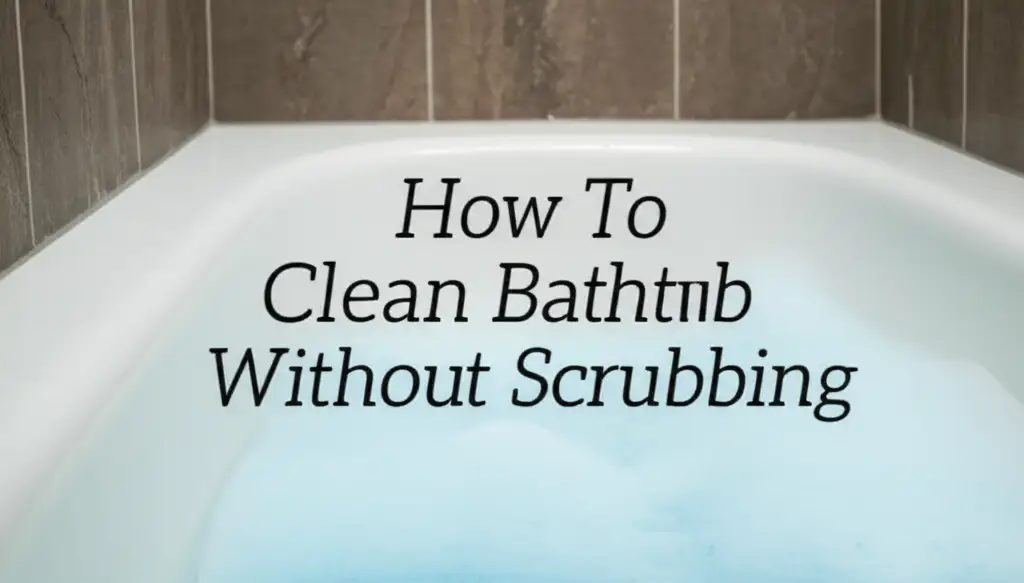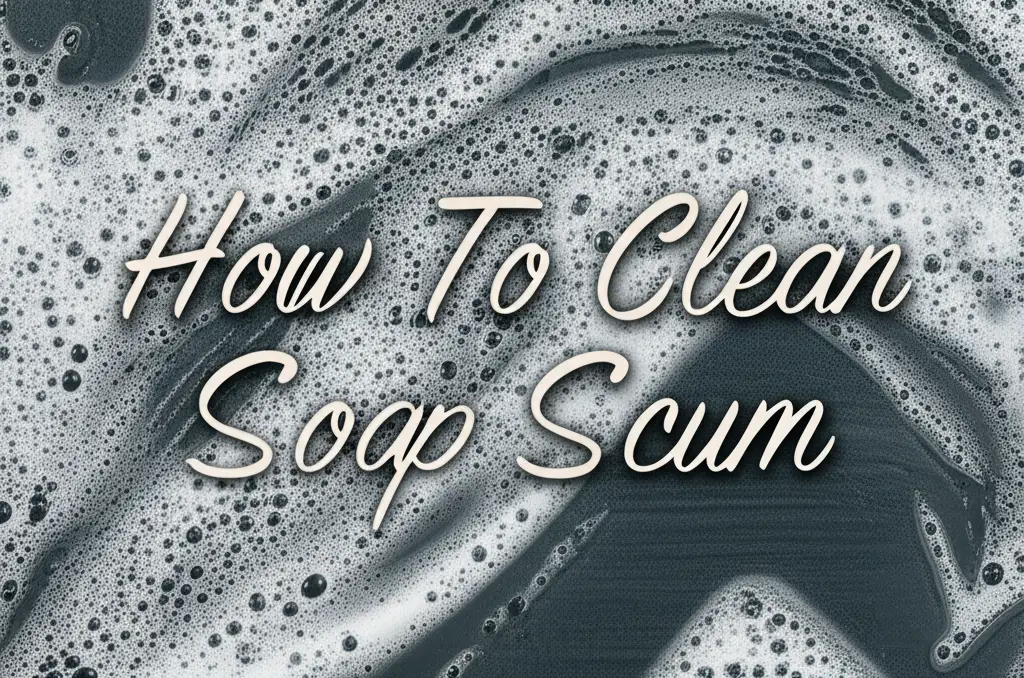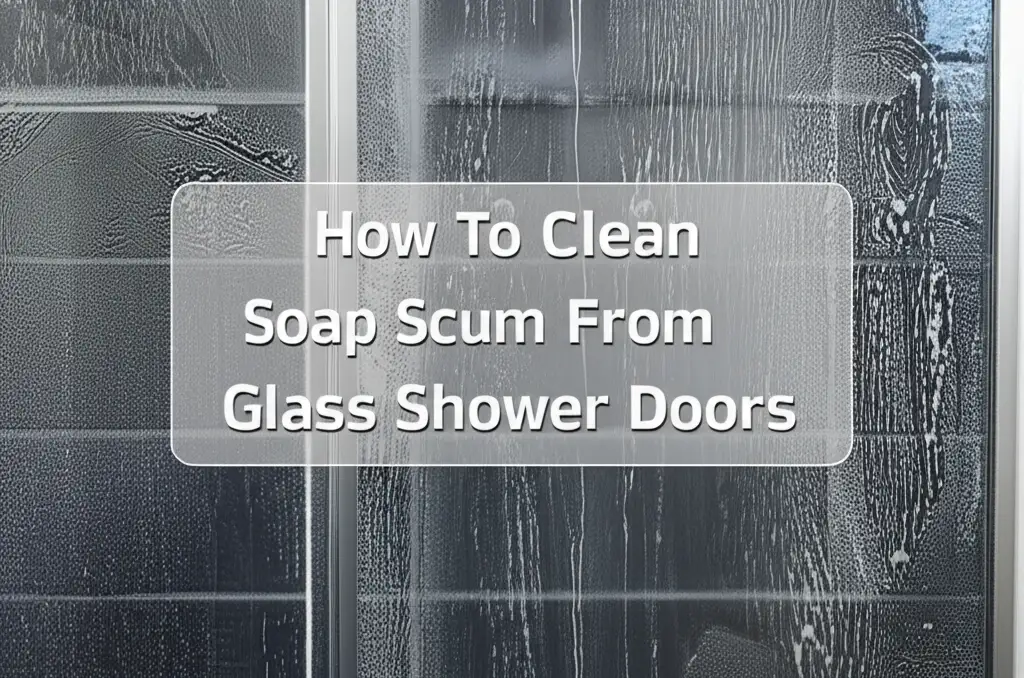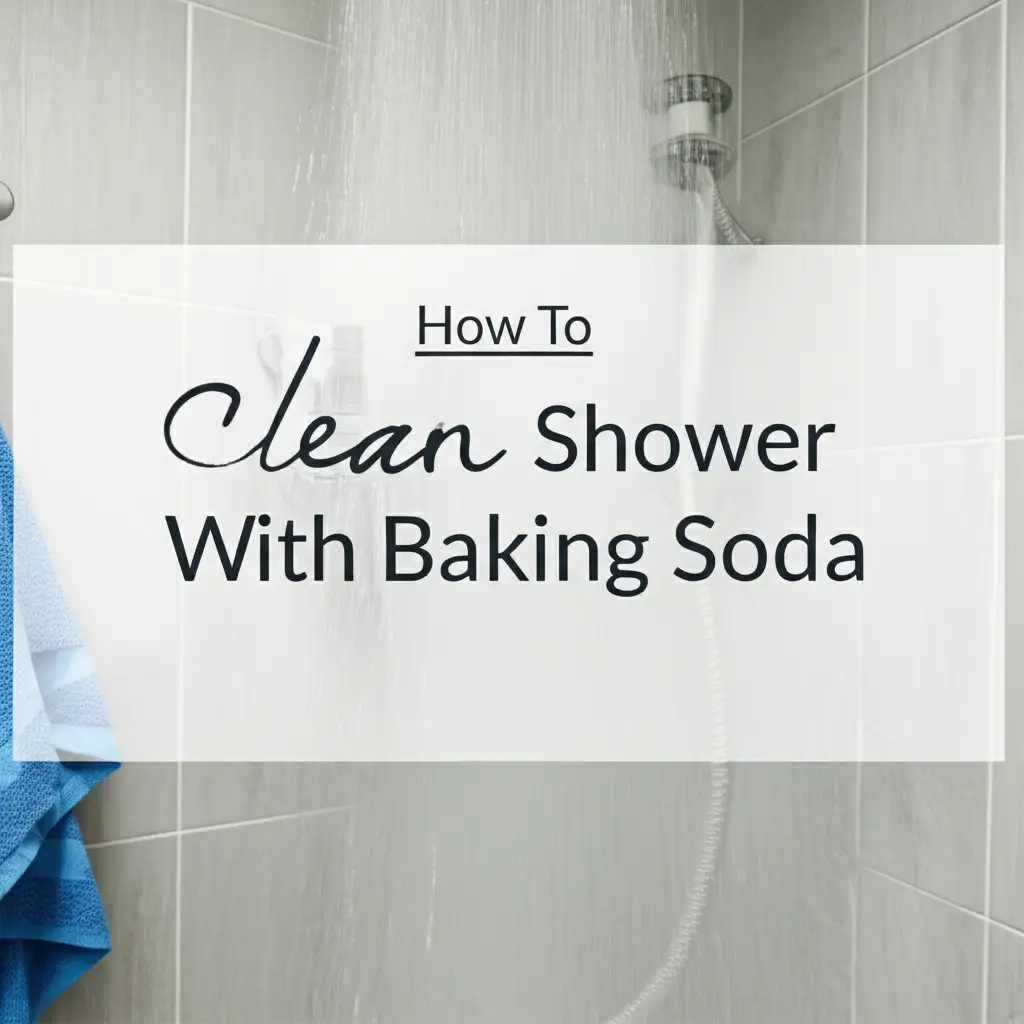· Home Cleaning · 14 min read
How To Clean Bathtub Without Scrubbing

Clean Your Bathtub Without Scrubbing: Easy Methods
Cleaning the bathtub can feel like a chore. I know the feeling of dread when faced with stubborn soap scum and grime. The thought of scrubbing on my hands and knees is enough to make me postpone it. But what if I told you there is a way? You can clean your bathtub without scrubbing. This is a game-changer for anyone who wants a sparkling tub with minimal effort.
This article shares simple, effective methods. We will explore how to use common household items like baking soda and vinegar. We will also look at specialized cleaners. You will learn how to tackle tough stains and prevent future buildup. Get ready to enjoy a clean bathroom without the hard work.
Takeaway
- Soak and Rinse: Use common household cleaners or specialized products. Let them sit to break down grime.
- Prevent Buildup: Rinse the tub after each use. Use daily spray cleaners.
- Choose Right Products: Match the cleaner to your tub material and stain type.
You can clean your bathtub effectively without scrubbing by letting cleaning agents do the hard work. Apply a solution like baking soda and vinegar or a no-scrub cleaner, allow it to soak for an extended period, and then rinse away the loosened dirt and grime. This method removes soap scum and stains with minimal physical effort.
Understanding No-Scrub Bathtub Cleaning Methods
No-scrub cleaning methods rely on chemical reactions. These reactions break down dirt and grime. This is different from manual scrubbing. Scrubbing uses friction to remove dirt. Our goal is to dissolve stains, not rub them away. This saves you time and physical effort.
Several types of no-scrub cleaners exist. Some use natural ingredients. Others are commercial products. Natural options often involve acids or abrasives. These interact with soap scum and hard water deposits. Commercial products use strong detergents or enzymes. These target specific types of dirt.
It is important to know your bathtub material. Some cleaners are safe for porcelain. Others work best on acrylic or fiberglass. Using the wrong product can damage your tub’s finish. Always read product labels. Test a small, hidden area first. This prevents problems later.
The key to success is patience. No-scrub methods need time to work. Apply the cleaner, then walk away. Let the solution sit for an hour or more. For very tough stains, you might need an overnight soak. This allows the cleaner to fully penetrate and break down the grime.
Baking Soda and Vinegar: The Power Duo for Hands-Free Cleaning
Baking soda and vinegar are household staples. They form a powerful cleaning combination. This pair creates a fizzing reaction. This reaction helps lift dirt and soap scum. It makes them easy to rinse away. This method is safe for many tub types.
Step-by-Step Baking Soda and Vinegar Method
- Rinse the tub: First, wet the entire tub surface with warm water. This helps prepare the surface. It also activates the cleaners.
- Apply baking soda: Sprinkle a generous amount of baking soda over the wet tub. Cover all dirty areas. For tougher spots, make a paste with a little water. Spread this paste over the stain. Baking soda is a mild abrasive. It helps absorb oils and odors.
- Spray with vinegar: Fill a spray bottle with white vinegar. Spray the vinegar directly over the baking soda. You will see it fizz and foam. This chemical reaction breaks down mineral deposits and soap scum. It also acts as a disinfectant.
- Let it sit: Allow the mixture to sit for at least 30 minutes. For heavily soiled tubs, let it sit for a few hours. Overnight is best for very stubborn stains. This gives the reaction time to work.
- Rinse thoroughly: After soaking, rinse the tub with warm water. Most of the grime should wash away easily. A soft cloth or sponge can help with any lingering bits. You do not need to scrub hard. This method is effective for general cleaning and light buildup.
This combination is excellent for regular maintenance. It keeps your tub fresh and clean. It avoids harsh chemicals. Many people use this method weekly. You can also use baking soda alone for some issues. Learn more about how to clean bathtub with baking soda. For general cleaning with vinegar, consider seeing how to clean shower with vinegar.
Dish Soap and Warm Water Soaks: Loosening Grime Effortlessly
Dish soap is designed to cut through grease. It works wonders on soap scum in bathtubs too. Soap scum is often a mix of body oils, dirt, and soap residue. Dish soap’s degreasing properties help break this down. This method is gentle and effective. It is perfect for light to moderate buildup.
Simple Dish Soap Soak Instructions
- Rinse the tub: Start by rinsing the entire bathtub with warm water. This warms the surface. It also helps loosen some loose dirt.
- Add dish soap: Pour about a half cup of liquid dish soap into the tub. Use a brand known for grease-cutting power. Spread it evenly over the tub surface. Focus on areas with more grime.
- Fill with warm water: Fill the tub with a few inches of very warm water. The warmer the water, the better. The heat helps activate the soap. It also aids in dissolving the soap scum.
- Let it soak: Let the soapy water sit in the tub for at least an hour. For heavier grime, let it soak for several hours. You can even leave it overnight. The longer it sits, the more effective it will be. The dish soap works to emulsify the dirt.
- Drain and rinse: After soaking, drain the tub. You will see the dirty water wash away. Rinse the tub thoroughly with clean water. Most of the grime should disappear. If a few spots remain, a quick wipe with a soft cloth will remove them. This method leaves your tub clean and shiny.
This technique is easy to do. It requires minimal active cleaning time. It is also safe for almost all tub materials. It’s an excellent way to maintain a clean tub without any hard scrubbing. It also works well for cleaning other bathroom surfaces. You can apply similar no-scrub ideas to how to clean shower tiles without scrubbing or even how to clean toilet bowl stains without scrubbing.
Specialized No-Scrub Cleaners: Chemical Solutions for Tough Stains
Sometimes, natural methods need a boost. Commercial no-scrub bathtub cleaners offer stronger solutions. These products use specific chemicals. They target tough stains like deep soap scum, mold, and mineral deposits. These cleaners are designed to work with minimal effort from you.
Types of No-Scrub Cleaners
- Foaming Cleaners: These cleaners spray on and expand. The foam clings to vertical surfaces. It allows the chemicals to penetrate stains better. You spray, wait, and rinse.
- Gel Cleaners: Gels are thicker. They stick to surfaces well. This ensures longer contact time with stubborn grime. They are good for targeted application on specific stains.
- Spray-and-Leave Products: Many brands offer daily shower or tub sprays. You spray them after showering. They prevent soap scum buildup over time. These are great for maintenance. They reduce the need for deep cleaning.
- Bleach-Based Cleaners: Some strong cleaners contain bleach. Bleach is excellent for mold, mildew, and tough stains. Use these in well-ventilated areas. Always follow safety instructions. Do not mix bleach with other cleaners, especially vinegar. Mixing can create dangerous fumes. For persistent mold issues, consider methods for how to clean mold in shower.
Using Specialized Cleaners Effectively
- Read Directions: Each product has specific instructions. Follow them closely. Pay attention to dwell time and safety warnings.
- Ventilation: Always ensure good airflow. Open windows or turn on the fan. This is especially important for strong chemical cleaners.
- Application: Spray or apply the cleaner evenly. Cover all dirty areas.
- Wait Time: Give the cleaner enough time to work. This can range from minutes to hours. The longer the soak, the better for tough stains.
- Rinse Thoroughly: After the waiting period, rinse the tub well with water. Ensure all cleaner residue washes away.
Specialized cleaners provide powerful stain removal. They are an excellent option when natural methods are not enough. They let you clean your bathtub without scrubbing.
Preventing Bathtub Buildup: Keeping Your Tub Clean Longer
The easiest way to clean your bathtub without scrubbing is to prevent it from getting dirty in the first place. Regular maintenance makes a big difference. It stops soap scum and grime from hardening. This means less effort for you down the line.
Daily Habits for a Cleaner Tub
- Rinse After Each Use: This is the simplest step. After every bath or shower, quickly rinse the tub. Use the showerhead to wash down the sides. This washes away loose soap and hair. This prevents them from drying and sticking.
- Wipe Down: If you have a few extra seconds, quickly wipe the tub with a soft cloth or squeegee. Do this especially for the bottom and sides. This removes any standing water. It reduces water spots and mineral buildup.
- Use a Daily Spray: Keep a bottle of daily shower or tub cleaner nearby. After showering, spray the entire tub surface. These sprays contain ingredients that prevent soap scum formation. They break down residue before it hardens. You do not need to rinse them. They work passively.
- Use Liquid Soap Over Bar Soap: Bar soap contains talc. Talc combines with hard water minerals. This forms stubborn soap scum. Liquid body wash or gel products are less likely to create this buildup. Making this switch can significantly reduce tub grime.
- Improve Ventilation: Good ventilation in your bathroom helps prevent mold and mildew. After showering, leave the fan running. Open a window if possible. This dries out the tub and shower area. Dampness promotes mold growth.
By adopting these small habits, you significantly reduce the need for deep cleaning. Your bathtub will stay cleaner, longer. This makes the occasional no-scrub deep clean even easier. Prevention is key to hands-free cleaning.
Tackling Specific Stains Without Scrubbing
Bathtubs can develop different types of stains. Each stain type needs a specific approach. Understanding the stain helps you choose the right no-scrub method.
Soap Scum
Soap scum is a common problem. It is a milky, dull film. It forms from soap residue, body oils, and hard water minerals.
- Method: The baking soda and vinegar method works well for soap scum. Dish soap soaks are also highly effective. For very thick scum, specialized no-scrub soap scum removers are best. These cleaners are designed to dissolve the waxy buildup.
- Application: Apply the chosen cleaner generously. Let it sit for at least an hour. For tough buildup, an overnight soak can work wonders. Then, simply rinse it away.
Hard Water Stains
Hard water contains minerals like calcium and magnesium. These minerals leave chalky white or reddish-brown spots. These are mineral deposits.
- Method: Acidic cleaners dissolve mineral deposits. White vinegar is a natural choice. For tougher stains, use a commercial descaling cleaner. Look for products designed for hard water.
- Application: Soak paper towels in white vinegar. Place these soaked towels directly on the hard water spots. Let them sit for several hours or overnight. The vinegar will break down the minerals. Then, rinse thoroughly. For widespread hard water, fill the tub with hot water and a few cups of vinegar. Let it soak.
Mold and Mildew
Mold and mildew appear as black, green, or pink fuzzy spots. They thrive in damp, humid environments.
- Method: Bleach-based cleaners are very effective against mold. Hydrogen peroxide also works. For a natural approach, use undiluted white vinegar. Vinegar kills many types of mold.
- Application: Spray the moldy areas with your chosen cleaner. Let it sit for 15-30 minutes. The mold should darken and loosen. Then, rinse the tub with hot water. Ensure good ventilation when using bleach. For detailed steps on removing mold, see how to clean mold with vinegar.
By targeting the specific stain, you ensure effective cleaning without the need for scrubbing. It is about letting the chemistry do the work.
Tools and Techniques for Minimal Effort Bathtub Care
Achieving a clean bathtub without scrubbing involves more than just cleaners. The right tools and a few smart techniques make the process even easier. These accessories complement your no-scrub strategy. They help ensure all grime washes away effortlessly.
Essential Tools for Hands-Free Cleaning
- Spray Bottles: These are crucial for applying liquid cleaners evenly. You can mix your own solutions, like vinegar and water. A good spray bottle ensures broad coverage without waste.
- Long-Handled Brush (Optional): While we avoid scrubbing, a long-handled brush with soft bristles can be helpful. Use it for a gentle sweep of the tub after soaking. This helps move loose grime towards the drain. It is not for scrubbing hard, but for guiding debris.
- Microfiber Cloths: Keep several clean microfiber cloths on hand. They are excellent for wiping down surfaces after rinsing. They absorb water well and leave no streaks. They can also gently wipe away any tiny remaining residue.
- Rubber Gloves: Protect your hands from cleaning solutions. Rubber gloves are essential, especially when using commercial cleaners.
- Squeegee: A squeegee helps remove water from the tub surface quickly. Use it after showering or cleaning. This reduces water spots and soap scum buildup. It is a preventative tool.
Smart Techniques for Effortless Results
- Pre-Rinse with Hot Water: Always start by rinsing the tub with very hot water. This warms the surface. It also helps loosen any loose dirt or hair. The heat also makes cleaners more effective.
- Generous Application: Do not be shy with the cleaner. Apply enough to thoroughly coat all dirty areas. The cleaner needs full contact to work.
- Adequate Soak Time: Patience is key. Give the cleaners enough time to break down the grime. Rushing the process will lead to less effective results. For very tough stains, extend the soak time.
- Multiple Applications for Tough Stains: For deeply embedded stains, one application might not be enough. You might need to repeat the process. Apply the cleaner, let it soak, rinse, and then reapply if needed. This layered approach can work better than one long soak for certain issues.
- Good Drainage: Ensure your tub drains well. Standing water after cleaning can leave new water spots. If your tub drains slowly, address that issue.
By using these simple tools and techniques, you can make your no-scrub bathtub cleaning routine even more effective. You will have a cleaner tub with minimal physical effort.
Frequently Asked Questions
Is it safe to use bleach to clean my bathtub without scrubbing?
Yes, you can use bleach for hands-free bathtub cleaning, especially for mold and mildew. Apply a bleach solution, let it sit for 15-30 minutes, then rinse. Always ensure good ventilation. Never mix bleach with other cleaners like ammonia or vinegar, as this creates dangerous fumes.
How often should I clean my bathtub using no-scrub methods?
For daily maintenance, use a daily shower spray after each use. For a deeper, no-scrub clean, doing it weekly or bi-weekly is often enough. Heavily used tubs or those with hard water might need attention more frequently. Listen to your tub’s needs.
Can no-scrub methods remove all types of bathtub stains?
No-scrub methods are highly effective for most common stains like soap scum, light hard water deposits, and mildew. Very old, deeply set stains or rust might require a specialized product or a very gentle, targeted wipe after soaking. The goal is to minimize effort.
Are no-scrub cleaners safe for all bathtub materials?
Most general no-scrub cleaners are safe for common materials like acrylic, fiberglass, and porcelain. However, always check the product label. Some strong acidic cleaners might not be suitable for older porcelain or certain finishes. When in doubt, test a small, hidden area first.
What if some grime remains after a no-scrub soak and rinse?
If a small amount of grime remains, it should be very loose. You can gently wipe it away with a soft cloth or sponge. No hard scrubbing should be needed. For tougher spots, reapply the cleaner and let it soak for a longer duration. Patience is key for dissolving tough buildup.
Conclusion
Cleaning your bathtub does not have to be a dreaded chore. We have explored several effective ways to clean your bathtub without scrubbing. From the natural power of baking soda and vinegar to the targeted action of specialized cleaners, you have options. These methods free you from the hard work. They rely on chemistry to dissolve grime and stains.
Remember that prevention is your best friend. Simple daily habits keep your tub cleaner for longer. Regularly rinsing, wiping, and using daily sprays make a big difference. This reduces the need for intense cleaning sessions. A clean tub enhances your bathroom’s appeal. It also provides a more relaxing space for you.
Now you have the knowledge and tools. You can maintain a sparkling clean bathtub with minimal effort. Say goodbye to endless scrubbing. Embrace these smart, hands-free cleaning solutions. Your knees and back will thank you!
- no-scrub bathtub cleaning
- easy bathroom cleaning
- soap scum removal
- hard water stains
- bathtub maintenance




